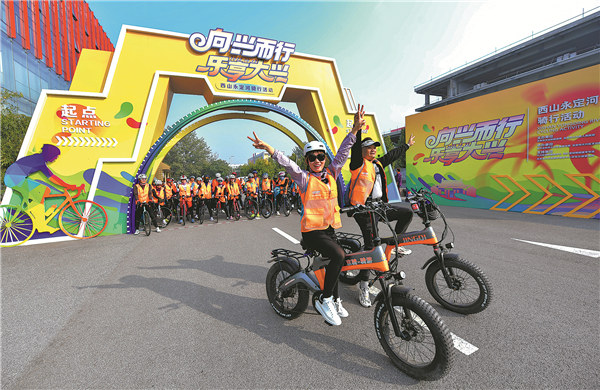

In recent years, Beijing has leveraged the geographical and resource advantages of its districts to continuously develop a number of unique intangible cultural heritage tourism routes and urban landmarks, transforming cultural and tourism resources into beautiful landscape and tangible assets that play a part of everyday life.
As one of the capital's three major cultural belts, the Western Hills and Yongding River region embodies natural and cultural resources characterized by the harmony of mountains and waters as well as a blend of strength and gentleness. The belt spans across or partially covers eight districts: Daxing, Fangshan, Mentougou, Shijingshan, Fengtai, Haidian, Changping and Yanqing, reflecting a rich reservoir of historical and cultural resources.
"One mountain and one river have provided a broader stage for the development of Beijing," said Zhu Lifeng, associate professor at the College of Art, Beijing Union University, adding that the Western Hills and Yongding River cultural belt intersects with the Great Wall cultural belt and the northsouth extension of the central axis, possessing abundant natural and historical cultural resources.
There should be active expansion of exchanges with national ICH projects and representative inheritors, support for the construction of ICH workshops and training centers in various districts, and promotion of tourism to create a cultural reception area for the Western Hills and Yongding River cultural belt, he added.
As a key area for the Western Hills and Yongding River cultural belt, Shijingshan has recently focused on the development of museums, showcasing the integration of the district's historical, modern, cultural and technological characteristics.
Chang Wei, Party secretary of Shijingshan, said the district will advance the construction of the Western Hills and Yongding River cultural belt with high standards, aiming to develop Shijingshan into a beautiful area where history and modernity, mountains and waters blend harmoniously.
In the northwest suburbs of Beijing, centered around the world cultural heritage site of the Summer Palace, there are historical cultural heritage clusters featuring Qing Dynasty (1644-1911) imperial gardens, including Xiangshan Mountain, Yuquan Mountain, Jingyi Garden, Jingming Garden in the north, Wanshou Mountain in the east, Changchun Garden, and Yuanmingyuan in the south. Those are renowned as the Three Mountains and Five Gardens.
Adjacent to the exhibition center of the Zhongguancun National Independent Innovation Demonstration Zone in the northwest corner of Haidian Park, a new cultural landmark — the Three Mountains and Five Gardens Cultural and Art Center — has risen.
By the end of September, the center will complete its interior decoration, and after meticulous display arrangements, it is expected to begin trial operations by the end of the year.
"In September 2020, construction of the center began, and once completed, it will systematically narrate the history and culture of the Three Mountains and Five Gardens, focusing on the restoration and display of Changchun Garden's appearance," said Li Zhi, head of the cultural heritage protection center of Haidian district.
This year, the Three Mountains and Five Gardens have been awarded the first batch of National Cultural Relic Protection and Utilization Demonstration Zone plaques, with the center becoming a new highlight.
Among the garden landscape, several elegant buildings combine traditional charm with modern style. This group of large public cultural facilities integrates cultural relic protection, art exhibitions and natural scenery, with a total construction area of 21,000 square meters, of which, approximately 19,000 sq m is underground, said Li.
"This allows for maximum coordination with the surrounding environment, maintaining the overall historical appearance of the Three Mountains and Five Gardens," he added.
The cultural and art center's main functions include the management, research, interpretation, and display of cultural heritage from the Three Mountains and Five Gardens and Haidian. The center enhances the benefits of cultural relic protection and utilization for the public. After opening, the center will become a "city reception room" that combines cultural heritage protection, cutting-edge technology releases, and natural ecological environment.
Currently, the cultural and art center is undergoing indoor electricity installation, security, decoration and exhibition construction. Entering the underground space from the main entrance, a large skylight introduces outdoor light, creating a bright and open feeling.
Li explained that the underground level includes two exhibition halls for temporary and special exhibitions and an educational activity space, which will feature some international exhibitions. The second underground level primarily consists of three exhibition halls for basic displays, with the main hall covering 1,000 sq m and two smaller halls each covering 500 sq m. Through historical and cultural exhibitions and digital immersive displays, it will systematically showcase the historical and cultural connotations of the Three Mountains and Five Gardens region, part of the Western Hills and Yongding River cultural belt.
"We are also creating a 'museum hospital' on the third underground level, responsible for researching and interpreting documents related to the Three Mountains and Five Gardens, and for the restoration and protection of relevant cultural relics. Future achievements in relic protection research will also be showcased in the exhibition halls," Li said.
Ma Yinghua, secretary-general of the digital heritage committee at the Chinese National Commission for the International Council on Monuments and Sites, said that, broadly speaking, the Three Mountains and Five Gardens are evolving from individual heritage sites to a series of heritage sites.
The area not only contains individual relics from Qing Dynasty royal gardens but also includes barracks, temples, palaces, and ancient waterways, with dual values of historical and Red cultural heritage.